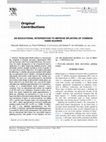Papers by Fiona Fitzpatrick

The Journal of emergency medicine, Jan 12, 2015
Hand trauma is a top presenting complaint to hospital emergency departments (EDs) and can become ... more Hand trauma is a top presenting complaint to hospital emergency departments (EDs) and can become costly if not treated effectively. The cornerstone for initial management of the traumatized hand is application of a splint. Improving splinting practice could potentially produce tangible benefits in terms of quality of care and costs to society. We sought to determine the following: 1) whether the present standard of ED splinting was appropriate and 2) whether a strategically planned educational intervention could improve the existing care. We used a pre- and postprospective educational intervention study design. In the preintervention phase, patients referred to our hand clinic were assessed for injury and splint type. Splinting appropriateness was evaluated according to a predetermined hand surgeons' expert consensus. Next, an educational intervention was targeted at all ED staff at our institution. Postintervention, all patients were again evaluated for splint appropriateness. ...

Background: Hand trauma is a top presenting complaint to hospital emergency departments (EDs) and... more Background: Hand trauma is a top presenting complaint to hospital emergency departments (EDs) and can become costly if not treated effectively. The cornerstone for initial management of the traumatized hand is application of a splint. Improving splinting practice could potentially produce tangible benefits in terms of quality of care and costs to society. Objectives: We sought to determine the following: 1) whether the present standard of ED splint-ing was appropriate and 2) whether a strategically planned educational intervention could improve the existing care. Methods: We used a pre-and postprospective educational intervention study design. In the preintervention phase, patients referred to our hand clinic were assessed for injury and splint type. Splinting appropriateness was evaluated according to a predetermined hand surgeons' expert consensus. Next, an educational intervention was targeted at all ED staff at our institution. Postintervention, all patients were again evaluated for splint appropriateness. A follow-up evaluation was performed at 1 year to see the long-term effects of the intervention. Results: The most common mechanism of injury of referred patients was falling (35%), and the most frequent injury was metacarpal fracture (40%). Splint appropriateness increased significantly postintervention from 49% to 69% (p = 0.048). At follow-up after 1 year, splinting appropriateness was 70% (p = 0.041). Conclusion: Appropriate hand splinting practice is essential for hand trauma management. Our results show that an educational intervention can successfully improve splinting practice. This quality of care initiative was low-cost and demonstrated persistence at 1 year of follow-up.









Uploads
Papers by Fiona Fitzpatrick